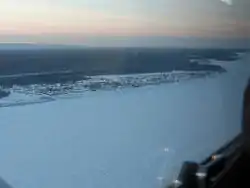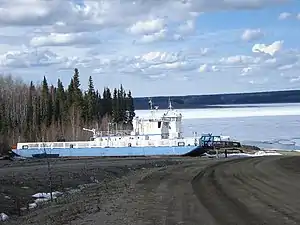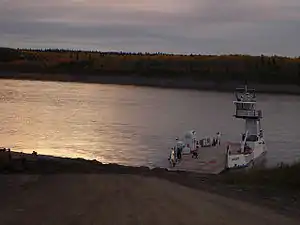Fort Simpson
Fort Simpson (Slavey language: Łı́ı́dlı̨ı̨ Kų́ę́ "place where rivers come together") is a village, the only one in the entire territory, in the Dehcho Region of the Northwest Territories, Canada. The community is located on an island at the confluence of the Mackenzie and Liard rivers. It is approximately 500 km (310 mi) west of Yellowknife.[8] Both rivers were traditionally trade routes for the Hudson's Bay Company and the native Dene people of the area.
Fort Simpson
Łı́ı́dlı̨ı̨ Kų́ę́ | |
|---|---|
Village | |
 | |
 Coat of arms | |
 Fort Simpson  Fort Simpson | |
| Coordinates: 61°51′39″N 121°21′10″W[1] | |
| Country | Canada |
| Territory | Northwest Territories |
| Region | Dehcho Region |
| Constituency | Nahendeh |
| Census division | Region 4 |
| Settled | 1803 |
| Village | 1822 |
| Village (incorporated) | 1 January 1973 |
| Government | |
| • Mayor | Sean Whelly |
| • Senior Administrative Officer | Kevin Corrigan |
| • MLA | Shane Thompson |
| Area | |
| • Land | 77.89 km2 (30.07 sq mi) |
| Elevation | 169 m (554 ft) |
| Population (2016)[3] | |
| • Total | 1,100 |
| • Density | 14.1/km2 (37/sq mi) |
| Time zone | UTC−07:00 (MST) |
| • Summer (DST) | UTC−06:00 (MDT) |
| Canadian Postal code | X0E 0N0 |
| Area code | 867 |
| Telephone exchange | 695 |
| - Living cost (2018) | 142.5A |
| - Food price index (2019) | 147.6B |
| Website | www.fort-Simpson.com |
| Sources: Department of Municipal and Community Affairs,[4] Prince of Wales Northern Heritage Centre,[5] Canada Flight Supplement[6] ^A 2018 figure based on Edmonton = 100[7] ^B 2019 figure based on Yellowknife = 100[7] | |
Fort Simpson is the regional centre of the Dehcho and is the gateway to the scenic South Nahanni River and the Nahanni National Park Reserve. Fort Simpson can be reached by air, water and road and has full secondary and elementary school service. The Mackenzie Highway was extended to Fort Simpson in 1970-71.
The central section of the community is on an island near the south bank of the Mackenzie River, but industrial areas and rural residential areas are located along the highway as far as the Fort Simpson Airport, just beyond which is the Liard River ferry crossing.
Demographics
In the 2021 Census of Population conducted by Statistics Canada, Fort Simpson had a population of 1,100 living in 452 of its 572 total private dwellings, a change of -8.5% from its 2016 population of 1,202. With a land area of 77.89 km2 (30.07 sq mi), it had a population density of 14.1/km2 (36.6/sq mi) in 2021.[3]
In 2016, 890 people identified as Indigenous peoples. Of these the majority, 770, of the residents are First Nations with 95 Métis and 20 Inuit. The main languages are South Slavey and English.[9]
| Year | Pop. | ±% |
|---|---|---|
| 1956 | 495 | — |
| 1961 | 563 | +13.7% |
| 1966 | 712 | +26.5% |
| 1971 | 747 | +4.9% |
| 1976 | 1,136 | +52.1% |
| 1981 | 980 | −13.7% |
| 1986 | 987 | +0.7% |
| 1991 | 1,142 | +15.7% |
| 1996 | 1,257 | +10.1% |
| 2001 | 1,163 | −7.5% |
| 2006 | 1,216 | +4.6% |
| 2011 | 1,238 | +1.8% |
| 2016 | 1,202 | −2.9% |
| 2021 | 1,100 | −8.5% |
| Source: Statistics Canada [3][9][10][11][12][13][14][15][16][17][18][19] | ||
|
| ||||||||||||||||||||||||||||||||||||||||||||||||||||||||||||||||||||||||||||||
| Sources: NWT Bureau of Statistics (2008 - 2019),[7] NWT Bureau of Statistics (2001 - 2017)[20] | |||||||||||||||||||||||||||||||||||||||||||||||||||||||||||||||||||||||||||||||
History
Fort Simpson was first started as a fur trading site in 1803 then named Fort of the Forks. The Village of Fort Simpson was a permanent settlement in July 1822 when the Hudson's Bay Company constructed a trading post, naming it for George Simpson, then the Governor of Rupert's Land. Until 1910 Fort Simpson was "a company town", with some participation by the Anglican and Roman Catholic Missions. The Dené know it as Łı́ı́dlı̨ı̨ Kų́ę́, meaning the place where the rivers come together.[21] It was designated a National Historic Site of Canada in 1969.[22]
Pope John Paul II attempted to visit the community in September 1984 as part of his Canadian tour, but was prevented from landing due to fog; in an address over the radio from Yellowknife, he promised to visit in the future. He did so in September 1987 near the end of the tour of the United States, making a side trip to Fort Simpson.
Culture
There are two main annual festivals which occur in Fort Simpson.
The first which is held in March is known as the "Beavertail Jamboree". This is a winter carnival which includes traditional games, snowmobile races, and talent shows.[23]
The other festival is the "Open Sky Festival" which is held annually on or around the Canada Day long weekend. The Open Sky Festival is a multi-disciplinary arts festival which has occurred annually since 2001. Festival events include musical, theatrical, and other performances as well as traditional Dehcho Dene Crafts, visual arts, new media exhibitions, workshops, and demonstrations. The Open Sky festival is hosted by the Open Sky Creative Society, a multi-disciplinary arts organization serving artists working in the Dehcho region.[24]
The Dene of the community are represented by the Łı́ı́dlı̨ı̨ Kų́ę́ First Nation[25] and the Métis by Fort Simpson Métis Local 52.[26] Both groups belong to the Dehcho First Nations.[27]
.jpg.webp) Welcome to Fort Simpson
Welcome to Fort Simpson_(38766481151).jpg.webp) Radio Station, Fort Simpson, circa 1925
Radio Station, Fort Simpson, circa 1925 Ehdaa National Historic Site of Canada on Canada Day 2011
Ehdaa National Historic Site of Canada on Canada Day 2011 Lafferty ferry dry docked for winter
Lafferty ferry dry docked for winter Liard River ferry Lafferty
Liard River ferry Lafferty
Climate
Fort Simpson has a subarctic climate (Köppen Dfc) with long, cold winters and warm but short summers. July temperatures are unusually warm for such northerly areas, which demonstrates the extreme continental nature of the area's climate. However, the heat quickly turns into long, cold winters when daylight hours turn drastically shorter. Transition seasons are extremely short, and the year is on average dominated by the winter and to a lesser extent, summer. The average monthly temperatures range from −24.2 °C (−11.6 °F) in January to 17.4 °C (63.3 °F) in July. Most of the precipitation falls during the summer months.
The highest temperature ever recorded in Fort Simpson was 36.6 °C (97.9 °F) on 25 July 1994 and 13 July 2014.[28][29] The coldest temperature ever recorded was −56.1 °C (−69.0 °F) on 1 February 1947.[30]
| Climate data for Fort Simpson (Fort Simpson Airport) WMO ID: 71946; coordinates 61°45′37″N 121°14′12″W; elevation: 169.2 m (555 ft); 1981–2010 normals, extremes 1895–present[lower-alpha 1] | |||||||||||||
|---|---|---|---|---|---|---|---|---|---|---|---|---|---|
| Month | Jan | Feb | Mar | Apr | May | Jun | Jul | Aug | Sep | Oct | Nov | Dec | Year |
| Record high humidex | 12.0 | 13.9 | 15.0 | 26.4 | 31.8 | 35.8 | 41.3 | 39.7 | 32.2 | 24.0 | 11.3 | 14.0 | 41.3 |
| Record high °C (°F) | 13.2 (55.8) |
15.6 (60.1) |
16.1 (61.0) |
25.5 (77.9) |
32.8 (91.0) |
35.0 (95.0) |
36.6 (97.9) |
35.4 (95.7) |
30.0 (86.0) |
25.6 (78.1) |
13.3 (55.9) |
14.5 (58.1) |
36.6 (97.9) |
| Average high °C (°F) | −19.8 (−3.6) |
−15.3 (4.5) |
−6.4 (20.5) |
5.8 (42.4) |
15.0 (59.0) |
21.8 (71.2) |
23.7 (74.7) |
20.9 (69.6) |
13.7 (56.7) |
1.8 (35.2) |
−11.5 (11.3) |
−17.5 (0.5) |
2.7 (36.9) |
| Daily mean °C (°F) | −24.2 (−11.6) |
−20.6 (−5.1) |
−13.0 (8.6) |
−0.4 (31.3) |
8.7 (47.7) |
15.3 (59.5) |
17.4 (63.3) |
14.7 (58.5) |
8.2 (46.8) |
−2.0 (28.4) |
−15.5 (4.1) |
−21.7 (−7.1) |
−2.8 (27.0) |
| Average low °C (°F) | −28.5 (−19.3) |
−25.9 (−14.6) |
−19.7 (−3.5) |
−6.7 (19.9) |
2.2 (36.0) |
8.8 (47.8) |
11.2 (52.2) |
8.5 (47.3) |
2.6 (36.7) |
−5.9 (21.4) |
−19.4 (−2.9) |
−25.9 (−14.6) |
−8.2 (17.2) |
| Record low °C (°F) | −54.4 (−65.9) |
−56.1 (−69.0) |
−46.7 (−52.1) |
−39.4 (−38.9) |
−22.8 (−9.0) |
−3.9 (25.0) |
−1.1 (30.0) |
−6.1 (21.0) |
−20.6 (−5.1) |
−27.8 (−18.0) |
−46.1 (−51.0) |
−53.3 (−63.9) |
−56.1 (−69.0) |
| Record low wind chill | −59 | −55 | −48 | −44 | −25 | −6 | −3 | −5 | −24 | −35 | −53 | −60 | −60 |
| Average precipitation mm (inches) | 18.9 (0.74) |
17.6 (0.69) |
15.4 (0.61) |
17.0 (0.67) |
29.4 (1.16) |
51.3 (2.02) |
61.1 (2.41) |
61.4 (2.42) |
32.2 (1.27) |
39.4 (1.55) |
24.8 (0.98) |
19.1 (0.75) |
387.6 (15.26) |
| Average rainfall mm (inches) | 0.2 (0.01) |
0.0 (0.0) |
0.1 (0.00) |
2.5 (0.10) |
21.0 (0.83) |
51.2 (2.02) |
61.1 (2.41) |
60.9 (2.40) |
28.5 (1.12) |
12.9 (0.51) |
0.1 (0.00) |
0.0 (0.0) |
238.6 (9.39) |
| Average snowfall cm (inches) | 27.4 (10.8) |
24.2 (9.5) |
19.0 (7.5) |
17.4 (6.9) |
7.6 (3.0) |
0.1 (0.0) |
0.0 (0.0) |
0.5 (0.2) |
4.2 (1.7) |
29.0 (11.4) |
33.4 (13.1) |
24.3 (9.6) |
187.0 (73.6) |
| Average precipitation days (≥ 0.2 mm) | 10.9 | 10.6 | 9.4 | 5.6 | 8.8 | 11.3 | 12.1 | 11.0 | 10.6 | 11.8 | 12.0 | 10.7 | 124.7 |
| Average rainy days (≥ 0.2 mm) | 0.2 | 0.1 | 0.2 | 1.0 | 7.1 | 11.3 | 12.1 | 11.0 | 9.8 | 4.2 | 0.2 | 0.0 | 57.1 |
| Average snowy days (≥ 0.2 cm) | 11.6 | 11.7 | 9.8 | 5.0 | 2.3 | 0.0 | 0.0 | 0.1 | 1.4 | 9.2 | 12.7 | 11.3 | 75.1 |
| Average relative humidity (%) (at 15:00) | 78.8 | 77.2 | 69.3 | 52.5 | 43.6 | 44.8 | 50.5 | 53.7 | 59.2 | 76.7 | 83.2 | 81.1 | 64.2 |
| Mean monthly sunshine hours | 55.7 | 95.1 | 180.6 | 248.6 | 293.4 | 313.0 | 307.1 | 263.8 | 163.9 | 77.8 | 49.4 | 30.0 | 2,078.3 |
| Percent possible sunshine | 28.5 | 38.0 | 49.6 | 56.3 | 53.8 | 53.7 | 53.3 | 53.4 | 42.0 | 25.0 | 22.8 | 17.7 | 41.2 |
| Source: Environment and Climate Change Canada[28][31][32][33][34][35][36][37][38][39][40][30][41][42][43][29] | |||||||||||||
Notable residents
- Jim Antoine, eighth premier of the Northwest Territories
- William Lafferty, politician, Canadian Forces officer and news paper columnist
- Melaw Nakehk'o, actress, artist, and activist
- Nick Sibbeston, fourth premier of the Northwest Territories.
- Dahti Tsetso, Tłı̨chǫ environmentalist and educator, born in Fort Simpson
See also
References
- "Fort Simpson". Geographical Names Data Base. Natural Resources Canada.
- "Fort Simpson". Geographical Names Data Base. Natural Resources Canada.
- "Population and dwelling counts: Canada, provinces and territories, and census subdivisions (municipalities), Northwest Territories". Statistics Canada. 9 February 2022. Retrieved 18 February 2022.
- "NWT Communities - Fort Simpson". Government of the Northwest Territories: Department of Municipal and Community Affairs. Retrieved 13 January 2014.
- "Northwest Territories Official Community Names and Pronunciation Guide". Prince of Wales Northern Heritage Centre. Yellowknife: Education, Culture and Employment, Government of the Northwest Territories. Archived from the original on 13 January 2016. Retrieved 13 January 2016.
- Canada Flight Supplement. Effective 0901Z 16 July 2020 to 0901Z 10 September 2020.
- Fort Simpson - Statistical Profile
- "Harper announces expansion of N.W.T. park". CBC News. 8 August 2007. Retrieved 1 November 2013.
- "Census Profile, 2016 Census Fort Simpson, Village [Census subdivision], Northwest Territories and Region 4, Region [Census division], Northwest Territories". Statistics Canada. 8 February 2017. Retrieved 1 February 2022.
- "Table 6: Population by census subdivisions, 1901–1961". 1961 Census of Canada (PDF). Series 1.1: Historical, 1901–1961. Vol. I: Population. Ottawa: Dominion Bureau of Statistics. 8 March 1963. Retrieved 1 February 2022.
- "Population of Unincorporated Places of 50 persons and over, 1971 and 1966 (Alberta)". 1971 Census of Canada: Population (PDF). Special Bulletin: Unincorporated Settlements. Vol. Bulletin SP—1. Ottawa: Statistics Canada. March 1973. Retrieved 1 February 2022.
- "1976 Census of Canada: Population - Geographic Distributions" (PDF). Statistics Canada. June 1977. Retrieved 1 February 2022.
- "1981 Census of Canada: Census subdivisions in decreasing population order" (PDF). Statistics Canada. May 1992. Retrieved 1 February 2021.
- "1986 Census: Population - Census Divisions and Census Subdivisions" (PDF). Statistics Canada. September 1987. Retrieved 1 February 2022.
- "91 Census: Census Divisions and Census Subdivisions - Population and Dwelling Counts" (PDF). Statistics Canada. April 1992. Retrieved 1 February 2022.
- "96 Census: A National Overview - Population and Dwelling Counts" (PDF). Statistics Canada. April 1997. Retrieved 1 February 2022.
- "Population and Dwelling Counts, for Canada, Provinces and Territories, and Census Subdivisions (Municipalities), 2001 and 1996 Censuses - 100% Data (Northwest Territories)". Statistics Canada. 15 August 2012. Retrieved 1 February 2022.
- "Population and dwelling counts, for Canada, provinces and territories, and census subdivisions (municipalities), 2006 and 2001 censuses - 100% data (Northwest Territories)". Statistics Canada. 20 August 2021. Retrieved 1 February 2022.
- "Population and dwelling counts, for Canada, provinces and territories, and census subdivisions (municipalities), 2011 and 2006 censuses (Northwest Territories)". Statistics Canada. 25 July 2021. Retrieved 1 February 2022.
- Population Estimates By Community from the GNWT
- Fort Simpson Historical Society Archived 2008-09-17 at the Wayback Machine
- Fort Simpson National Historic Site of Canada. Directory of Federal Heritage Designations. Parks Canada. Retrieved 11 October 2013.
- Explore NWT - Beavertail Jamboree Archived 2006-11-18 at the Wayback Machine
- Open Sky Creative Society
- Liidli Kue First Nation Archived 2008-03-02 at the Wayback Machine
- Fort Simpson Métis Archived 2008-03-02 at the Wayback Machine
- Dehcho First Nations Archived 2007-02-03 at the Wayback Machine
- "Fort Simpson A". Canadian Climate Normals 1981–2010. Environment Canada. 25 September 2013. Climate ID: 2202101. Retrieved 19 October 2020.
- "Daily Data Report for July 2014". Canadian Climate Data. Environment and Climate Change Canada. Climate ID: 2202101. Retrieved 30 June 2016.
- "Daily Data Report for February 1947". Canadian Climate Data. Environment and Climate Change Canada. 31 October 2011. Climate ID: 2202100. Retrieved 30 June 2016.
- "Daily Data Report for May 1899". Canadian Climate Data. Environment and Climate Change Canada. Climate ID: 2202100. Retrieved 30 June 2016.
- "Daily Data Report for June 1916". Canadian Climate Data. Environment and Climate Change Canada. 31 October 2011. Climate ID: 2202100. Retrieved 30 June 2016.
- "Daily Data Report for August 1922". Canadian Climate Data. Environment and Climate Change Canada. Climate ID: 2202100. Retrieved 30 June 2016.
- "Daily Data Report for October 1923". Canadian Climate Data. Environment and Climate Change Canada. 31 October 2011. Climate ID: 2202100. Retrieved 30 June 2016.
- "Daily Data Report for March 1929". Canadian Climate Data. Environment and Climate Change Canada. Climate ID: 2202100. Retrieved 30 June 2016.
- "Daily Data Report for December 1933". Canadian Climate Data. Environment and Climate Change Canada. Climate ID: 2202100. Retrieved 30 June 2016.
- "Daily Data Report for October 1935". Canadian Climate Data. Environment and Climate Change Canada. Climate ID: 2202100. Retrieved 30 June 2016.
- "Daily Data Report for January 1936". Canadian Climate Data. Environment and Climate Change Canada. Climate ID: 2202100. Retrieved 30 June 2016.
- "Daily Data Report for February 1938". Canadian Climate Data. Environment and Climate Change Canada. Climate ID: 2202100. Retrieved 30 June 2016.
- "Daily Data Report for November 1941". Canadian Climate Data. Environment and Climate Change Canada. Climate ID: 2202100. Retrieved 30 June 2016.
- "Daily Data Report for November 1949". Canadian Climate Data. Environment and Climate Change Canada. Climate ID: 2202100. Retrieved 30 June 2016.
- "Daily Data Report for April 1954". Canadian Climate Data. Environment and Climate Change Canada. Climate ID: 2202100. Retrieved 30 June 2016.
- "Daily Data Report for June 1955". Canadian Climate Data. Environment and Climate Change Canada. Climate ID: 2202100. Retrieved 30 June 2016.
- Climate data was recorded in Fort Simpson from November 1895 to October 1963 and at Fort Simpson Airport from November 1963 to present.